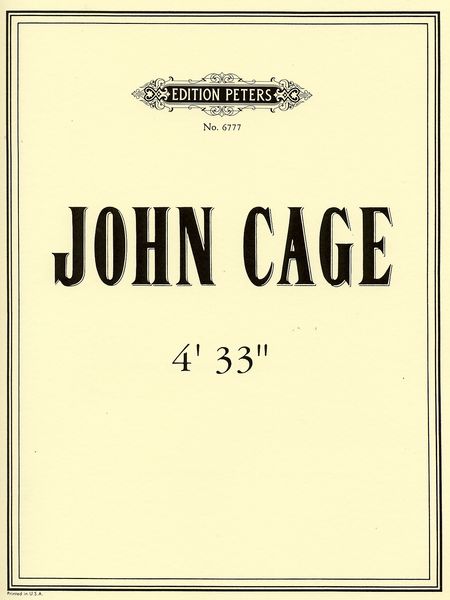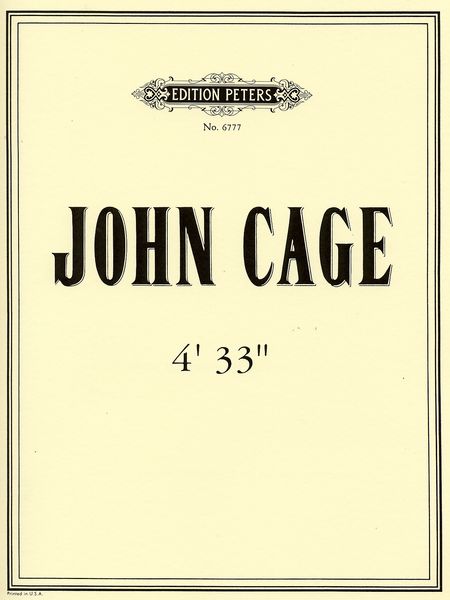Listening…: John Cage
Publisert
John Cage studerte bl.a. med Arnold Schoenberg. Som komponist og skribent ble han en av de mest innflytelsesrike tenkere innen musikkfeltet på 1900-tallet.
Vi leser teksten the future of music: credo av John Cage fra 1937, og lytter til utdrag fra verk som In a Landscape (1948), Sonatas and Interludes for Prepared Piano (1948), Inderterminacy, Music of Changes (1951) og Williams Mix (1952). I tillegg er det mange video-godbiter nedenfor.
Anbefalt litteratur
John Cage (1937): the future of music: credo. Ch. 6 in Audio Culture. Readings in modern music, ed. by C. Cox and D. Warner. Also available online
John Cage (1961): Silence: Lectures and Writings. Wesleyan U.P.,U.S., 1961.
Brandon LaBelle (2006): Background Noise. Perspectives on Sound Art, chapters 1 and 2. Continuum, London. (Drøftingen av John Cage i forhold til Musique Concrete på slutten av kapittel 2 anbefales spesielt).
Webressurser
Video
John Cage – 4’33”. Performed by David Tudor
John Cage – 4’33”. Performed by The BBC Philarmonic Orchestra
Four American Composers: John Cage (1983). Documentary film. Directed by Peter Greenaway
_Variations V, 1965
Music: John Cage
Film: Stan VanDerBeek
TV images: Nam June Paik
Dancers: Merce Cunningham Dance Company_
John Cage made «Variations V» in 1965 for the Merce Cunningham Dance Company. He and David Tudor settled on two systems for the sound to be affected by movement. For the first, Billy Klüver and his colleagues set up a system of directional photocells aimed at the stage lights, so that the dancers triggered sounds as they cut the light beams with their movements. A second system used a series of antennas. When a dancer came within four feet of an antenna a sound would result. Ten photocells were wired to activate tape-recorders and short-wave radios. Cecil Coker designed a control circuit, which was built by my assistant Witt Wittnebert. Film footage by Stan VanDerBeek and Nam June Paik’s manipulated television images were projected on screens behind the dancers.
The score was created by flipping coins to determine each element and consisted of thirty-five «remarks» outlining the structure, components, and methodology. The specific sound score would change at each performance as it was created by radio antennas responding to the dancers’ movements.
In this photograph «Variations V» is performed for a television taping session in Hamburg. The photocells were located at the base of the five-foot antennas placed around the stage. Cage, Tudor, and Gordon Mumma operate equipment to modify and determine the final sounds.
The project was also presented at the Philharmonic Hall in New York, 1965.
_Changing Steps, 1975
Music: John Cage
Design: Charles Atlas (Mark Lancaster, 1978)
Dancers: Merce Cunningham Dance Company_
_Beach Birds For Camera, 1992 (a 35mm film directed by Elliot Caplan)
Music: John Cage
Design: Marsha Skinner
Dancers: Merce Cunningham Dance Company_
Chance Conversations: An Interview with Merce Cunningham and John Cage.
—-
About Listening to Donald Judd
Sound is becoming an integrated part of contemporary artistic practices. Artists working with sound are relating to and crossing the boundaries between contemporary fine arts, sound art, sound in the arts, contemporary music, popular music, experimental music, electronic music and more, all with their particular and interweaving histories and discourses.
This course will encourage an increased awareness and appreciation of the different perspectives, when listening to sound and music as well as through the development of a language for discussing sound and music.
We will meet for 1-2 hours at regular intervals (approx. every 2-3 weeks) to listen to, discuss and analyze a selection of works spanning the history of sound art as well as contemporary and popular music, combined with collective readings of selected relevant texts.
The course is a collaboration between BEK and Bergen National Academy of the Arts.

